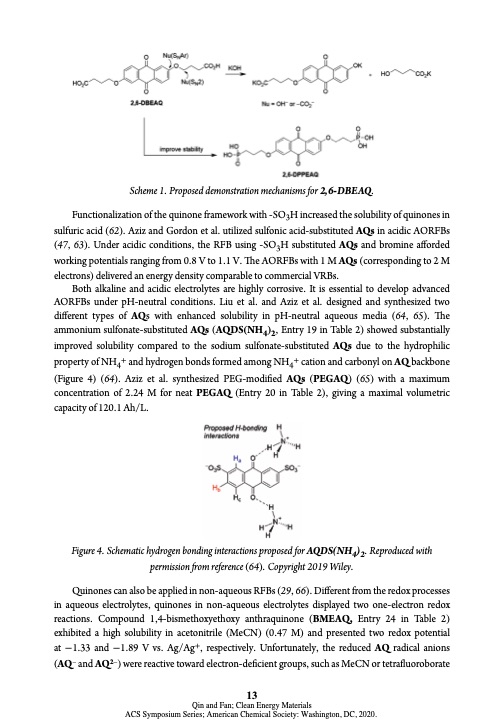
PDF Publication Title:
Text from PDF Page: 013
Scheme 1. Proposed demonstration mechanisms for 2,6-DBEAQ. Functionalization of the quinone framework with -SO3H increased the solubility of quinones in sulfuric acid (62). Aziz and Gordon et al. utilized sulfonic acid-substituted AQs in acidic AORFBs (47, 63). Under acidic conditions, the RFB using -SO3H substituted AQs and bromine afforded working potentials ranging from 0.8 V to 1.1 V. The AORFBs with 1 M AQs (corresponding to 2 M electrons) delivered an energy density comparable to commercial VRBs. Both alkaline and acidic electrolytes are highly corrosive. It is essential to develop advanced AORFBs under pH-neutral conditions. Liu et al. and Aziz et al. designed and synthesized two different types of AQs with enhanced solubility in pH-neutral aqueous media (64, 65). The ammonium sulfonate-substituted AQs (AQDS(NH4)2, Entry 19 in Table 2) showed substantially improved solubility compared to the sodium sulfonate-substituted AQs due to the hydrophilic property of NH4+ and hydrogen bonds formed among NH4+ cation and carbonyl on AQ backbone (Figure 4) (64). Aziz et al. synthesized PEG-modified AQs (PEGAQ) (65) with a maximum concentration of 2.24 M for neat PEGAQ (Entry 20 in Table 2), giving a maximal volumetric capacity of 120.1 Ah/L. Figure 4. Schematic hydrogen bonding interactions proposed for AQDS(NH4)2. Reproduced with permission from reference (64). Copyright 2019 Wiley. Quinones can also be applied in non-aqueous RFBs (29, 66). Different from the redox processes in aqueous electrolytes, quinones in non-aqueous electrolytes displayed two one-electron redox reactions. Compound 1,4-bismethoxyethoxy anthraquinone (BMEAQ, Entry 24 in Table 2) exhibited a high solubility in acetonitrile (MeCN) (0.47 M) and presented two redox potential at −1.33 and −1.89 V vs. Ag/Ag+, respectively. Unfortunately, the reduced AQ radical anions (AQ– and AQ2–) were reactive toward electron-deficient groups, such as MeCN or tetrafluoroborate 13 Qin and Fan; Clean Energy Materials ACS Symposium Series; American Chemical Society: Washington, DC, 2020.PDF Image | Electroactive Materials Next-Generation Redox Flow Batteries

PDF Search Title:
Electroactive Materials Next-Generation Redox Flow BatteriesOriginal File Name Searched:
bk-2020-1364.ch001.pdfDIY PDF Search: Google It | Yahoo | Bing
Salgenx Redox Flow Battery Technology: Salt water flow battery technology with low cost and great energy density that can be used for power storage and thermal storage. Let us de-risk your production using our license. Our aqueous flow battery is less cost than Tesla Megapack and available faster. Redox flow battery. No membrane needed like with Vanadium, or Bromine. Salgenx flow battery
| CONTACT TEL: 608-238-6001 Email: greg@salgenx.com | RSS | AMP |